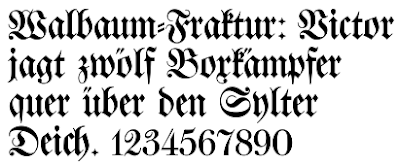When I started teaching myself to read German script about four years ago, I knew practically no German. I had picked up some German words and phrases as a kid from my parents, but I had forgotten most of those, and I had traveled some in German and learned airport and railroad German (Flughafen, Hauptbahnhof, etc.). But I knew very little that was relevant to genealogy. So don't think that I am some super German speaker.
German script is properly called Kurrentschrift, and it developed from medieval cursive and was used in Germany until the Nazis banned it in 1941. It is often called Gothic script, but this is not correct as Gothic refers to a type of printing with wide black letters used in many European languages.
Here is an example of Kurrentschrift handwriting:
 | |||
| Source: https://upload.wikimedia.org/wikipedia/commons/5/59/Deutsche_Kurrentschrift.svg |
 |
| Source: https://en.wikipedia.org/wiki/Fraktur#/media/File:Fraktur_walbaum.png |
The first and most important step to teaching yourself to read Kurrentschrift is to determine that you will keep at it until you succeed. I guarantee it will be frustrating at times, but you can't quit until have succeeded. If you're not willing to make this resolve, don't waste your time starting. When you get discouraged, remember the genealogical treasures troves you will uncover by persisting.
Second, the Family History Library in Salt Lake City, Utah, has a good guide to the alphabet. Read it and practice writing the letters several times until you are comfortable with them. This is just like learning the alphabet in kindergarten.
Third, Brigham Young University has a tutorial to teach you to read Kurrentschrift. Go through each section of the tutorial (listed on the left side of the home page) and learn to write words in Kurrentschrift. Writing it yourself is important because that burns it into your active memory (as opposed to reading which is only passive). Then you can take a little test at the end to see how well you are doing.
You have your homework - get started and let us know about your progress with a comment.
(In the next post, we will discuss how to read an actual page from a Mennonite church book.)
No comments:
Post a Comment